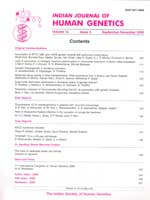
|
Indian Journal of Human Genetics
Medknow Publications on behalf of Indian Society of Human Genetics
ISSN: 0971-6866
EISSN: 0971-6866
Vol. 12, No. 3, 2006, pp. 116-119
|
 Bioline Code: hg06021
Bioline Code: hg06021
Full paper language: English
Document type: Research Article
Document available free of charge
|
|
|
Indian Journal of Human Genetics, Vol. 12, No. 3, 2006, pp. 116-119
| en |
Genetic heterogeneity in duodenal ulceration
Venkateshwari A, Vidyasagar A, Pratibha N
Abstract
Background: Duodenal ulcer (DU) is a multifactorial disorder with different etiological and pathogenetic mechanisms. Evidence for the role of genetic factors such as familial aggregation, twin studies, ABO blood groups, ABH nonsecretor status and hyperpepsinogenemia have been reported in DU. Genetic heterogeneity of cases with familial incidence will provide information regarding the association of qualitative and quantitative traits.
Aim: Hence, the present study is envisaged at identifying the segregant and deviant groups based on parental phenotypes and their association with other quantitative markers.
Materials and Methods: 62 out of 462 endoscopically confirmed duodenal ulcer cases were considered for the analysis of genetic heterogeneity. This was resolved through the calculation of genetic risk estimates of sporadic cases in multiplex families based on different modes of inheritance and variation in associated genetic and biochemical markers.
Results: Mean age at onset in simplex and multiplex cases was found to vary indicating the presence of genetic heterogeneity in the expression of the disease. Segregant and deviant groups were identified based on mortons probability risk estimates and examined for the possible association of qualitative and quantitative markers such as pepsinogen phenotype, serum and tissue pepsinogen levels, cathepsin E, malondialdehyde and ceruloplasmin levels.
Conclusions: The study thus highlighted the presence of genetic heterogeneity in the expression of the disease. The risk factors associated with segregant type were normal serum and tissue pepsinogen levels increased malondialdehyde levels and association of AC phenotype while the deviant group was characterized by early age at onset with hyper pepsinogenemia and reduced cathepin E levels.
Keywords
Age at onset, cathepsin E, deviant families, duodenal ulcer, genetic heterogeneity, pepsinogen, segregant
|
| |
© Copyright 2006 Indian Journal of Human Genetics.
Alternative site location: http://www.ijhg.com/
|
|
